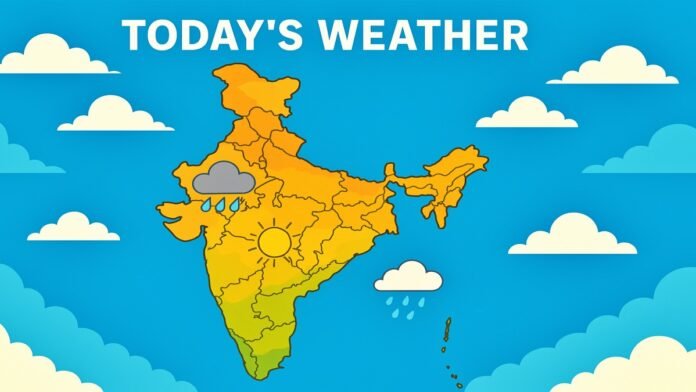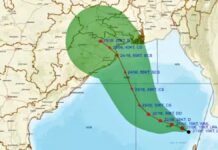
Key Points:
- IMD issues alert for fresh Western Disturbance affecting Western Himalayan region from November 4, 2025, bringing thunderstorms with wind speeds of 40-50 km/h to Jammu & Kashmir, Himachal Pradesh, and Uttarakhand
- Snowfall expected in higher reaches of Kullu, Kinnaur, and Lahaul-Spiti in Himachal Pradesh on November 4-5, with rainfall in lower areas including Shimla, Solan, and Mandi
- Low-pressure area over east-central Bay of Bengal and Myanmar coast triggers heavy rainfall warnings for Andaman & Nicobar Islands, with thunderstorms and gusty winds (30-40 km/h) from November 2-5
- Delhi’s air quality deteriorates to ‘very poor’ category with AQI reaching 319 on November 3, down from 377 on November 2; multiple monitoring stations recorded ‘severe’ levels above 400
- Heavy rainfall expected across northeastern states including Arunachal Pradesh, Assam, Meghalaya, Nagaland, Manipur, Mizoram, and Tripura on November 3
- Thunderstorm alerts issued for Gujarat, Marathwada, Konkan-Goa, and Maharashtra from November 2-5, with warnings of traffic disruption and waterlogging in Mumbai and Pune
- PM2.5 concentration in Delhi measured at 168 µg/m³ 11.6 times above WHO’s recommended limit of 15 µg/m³
New Delhi: A fresh Western Disturbance is set to sweep across the Western Himalayan region starting November 4, 2025, marking a significant weather shift that will bring snowfall to higher altitudes and intensify winter conditions across northern India. The India Meteorological Department (IMD) issued an official press release on November 2, 2025, warning residents and tourists in hill states to prepare for inclement weather conditions.
Himalayan States Brace for Snow and Rain
The approaching Western Disturbance will trigger widespread weather changes across Jammu and Kashmir, Himachal Pradesh, and Uttarakhand. Meteorological forecasts indicate thunderstorms accompanied by strong gusty winds with speeds reaching 40-50 km/h in these regions. Higher elevations in Himachal Pradesh, particularly districts like Kullu, Kinnaur, and Lahaul-Spiti, are expected to receive moderate to heavy snowfall on November 4 and 5. Meanwhile, lower-altitude areas, including Shimla, Solan, and Mandi, will experience rainfall during the same period.
Uttarakhand’s Mountain Districts Face Cold Wave
The mountainous districts of Uttarakhand are set to experience a sharp temperature drop as the cold wave intensifies. Snowfall is predicted in the higher elevations on November 4 and 5, potentially affecting popular tourist destinations and high-altitude trekking routes. According to the IMD bulletin issued on October 31, light to moderate rain and snowfall are expected across the western Himalayan region between November 3 and 5. However, November 3 is expected to see relatively clear weather in Himachal Pradesh before the disturbance intensifies. Light fog may prevail in the plains of Uttarakhand on November 3, reducing visibility during morning hours.
Early Winter Snowfall Pattern
This snowfall event comes on the heels of unusually early winter precipitation that hit Himachal Pradesh and Uttarakhand in mid-October 2025, weeks ahead of the typical schedule. Districts like Kullu, Lahaul-Spiti, and Kinnaur had already reported heavy snow in October, with areas such as Gondhla witnessing nearly 30 cm and Keylong recording around 15 cm of accumulation. Meteorologists have attributed this early onset to unusual weather patterns, potentially linked to western disturbances and a possible La Niña phenomenon.
Bay of Bengal Low-Pressure System Triggers Coastal Rains
A low-pressure area has formed over the east-central Bay of Bengal and the adjoining Myanmar coast, significantly influencing weather patterns across eastern and southern India. Under the influence of this system, heavy rainfall is expected at isolated places over the Andaman and Nicobar Islands on November 2 and 3, 2025. The IMD has also issued warnings for thunderstorms with lightning and gusty winds reaching speeds of 30-40 km/h over the island territory from November 2 to 5.
Western and Central India on Alert
Western India, particularly the Konkan and Goa region, experienced light to moderate rainfall with heavy showers at isolated places on November 2. The meteorological department has issued thunderstorm warnings for multiple states in western India through November 5. Gujarat is expected to experience lightning on November 2, while Marathwada faces similar conditions on November 2-3. Konkan-Goa will see renewed thunderstorm activity on November 5, and Madhya Maharashtra on November 2 and 5. Major cities like Mumbai and Pune were warned of potential traffic jams and waterlogging problems due to the heavy rainfall.
Northeast India Receives Heavy Rainfall
The northeastern states of India, including Arunachal Pradesh, Assam, Meghalaya, Nagaland, Manipur, Mizoram, and Tripura, are experiencing widespread rainfall on November 3. The IMD bulletin highlights that light to moderate rain is occurring at many places across the Andaman and Nicobar Islands, with heavy showers continuing in some areas. This rainfall is part of the broader weather system affecting East and Central India since Sunday, November 2.
Madhya Pradesh Under Thunderstorm Watch
The Meteorological Department has issued specific alerts for Madhya Pradesh, with thunderstorm and lightning warnings in effect from November 2-4 for the western parts of the state. East Madhya Pradesh and the Vidarbha region also received similar warnings for November 2. According to IMD officials, while this rainfall could prove beneficial for crops, there is also concern about potential flooding in low-lying areas.
Delhi-NCR Gasps Under Hazardous Air Pollution
Delhi’s air quality has plunged to dangerous levels, with the overall Air Quality Index (AQI) reaching 319 on Monday, November 3, 2025, as measured by the Central Pollution Control Board (CPCB) at 9 am. This represents a slight improvement from Sunday’s reading of 377, but the air quality remains firmly in the ‘very poor’ category for the second consecutive day. The Air Quality Early Warning System (EWS) predicts that Delhi will continue to experience ‘very poor’ air quality levels through Tuesday, November 4.
Severe Pollution Hotspots Emerge
Multiple monitoring stations across Delhi recorded AQI levels exceeding 400, placing them in the ‘severe’ category, the worst possible classification. The most affected areas on November 3 included Goutampuri (408), Holambi Khurd Village (561), Maharam Mohalla (344), Mustafabad (380), and Shahdara (312). On the previous day, November 2, Wazirpur and RK Puram were the worst-hit areas with AQI levels of 432 and 425, respectively, at 7 am, along with 18 other stations recording ‘severe’ levels. According to the CPCB, among Delhi’s 39 air monitoring stations, the vast majority registered readings in the ‘very poor’ category on November 3.
Health Impact Equivalent to Smoking Multiple Cigarettes
The private air quality monitor AQI.in reported that breathing Delhi’s air on November 3 is as harmful as smoking 7.8 cigarettes per day, based on average PM2.5 concentration over the past 24 hours. The PM2.5 concentration was measured at 168 µg/m³, a staggering 11.6 times above the World Health Organization’s recommended guideline of 15 µg/m³. The WHO warns that exposure to PM2.5 can cause diseases affecting both the cardiovascular and respiratory systems, including stroke, lung cancer, and chronic obstructive pulmonary disease (COPD). Data also reveals a 7.3 percent rise in pollution levels compared to last year, with November 2024’s average AQI at 285 versus 306 this November.
Neighboring Cities Equally Affected
The pollution crisis extends beyond Delhi’s borders, with neighboring NCR cities reporting similarly hazardous air quality levels. Ghaziabad recorded an AQI of 360, Noida 289, Greater Noida 306, and Gurugram 201 on November 3. According to the CPCB classification, an AQI between 0-50 is considered ‘good’, 51-100 ‘satisfactory’, 101-200 ‘moderate’, 201-300 ‘poor’, 301-400 ‘very poor’, and 401-500 ‘severe’.
Meteorological Factors Worsen Air Quality
The deterioration in Delhi’s air quality is primarily attributed to weak wind conditions that prevent the dispersion of pollutants. The AQEWS noted that wind speeds dropped below 8 km/h from the northwest direction during evening and night hours, significantly reducing pollutant dispersion. According to the IMD, Delhi recorded a maximum temperature of 30.7 degrees Celsius on Sunday, 0.5 degrees below the seasonal average, while the minimum settled at 16.8 degrees Celsius, 1.5 degrees above normal. The humidity level stood at 75 percent. The weather office has forecast shallow fog for Monday, with maximum and minimum temperatures likely to hover around 30 and 15 degrees Celsius, respectively.
Government Implements Pollution Control Measures
To combat the worsening air quality, the Delhi government has implemented several emergency measures. A ban on the entry of commercial vehicles not registered in Delhi and not compliant with BS-III or lower emission standards came into force on November 1. Old commercial and diesel vehicles from other states, including trucks, pickups, and BS-III or older diesel vehicles, are no longer allowed into the city. To enforce these regulations, 23 inspection teams from the Transport Department and Traffic Police have been deployed at key entry points such as Kundli, Tikri, Rajokri, Aya Nagar, and Kalindi Kunj.
Targeted Action in Pollution Hotspots
Delhi Environment Minister Manjinder Singh Sirsa inspected pollution-control measures at Anand Vihar, one of the city’s most severely affected areas. He confirmed that there are 13 identified pollution hotspots across Delhi and assured that the government is closely monitoring and addressing each of them. The government is installing permanent water sprinklers in these hotspots to help suppress dust particles and reduce pollution levels.
Weather Outlook for Uttar Pradesh and Bihar
The weather forecast for Uttar Pradesh indicates dry conditions across both western and eastern parts of the state on November 3. Shallow to moderate fog may occur at isolated places during morning hours, potentially affecting visibility. However, there is no expectation of rain or strong gusty winds in Uttar Pradesh during this period. Meanwhile, Bihar is expected to experience normal weather conditions for the next 3-4 days, with no significant rainfall anticipated. Light fog or mist may persist during morning and late evening hours. The wind direction will be predominantly northwesterly, which will contribute to an increase in cold conditions across the state.
The converging weather systems, the Western Disturbance from the north, and the low-pressure area from the Bay of Bengal mark a significant transition from post-monsoon conditions to early winter weather patterns across India. As temperatures begin their seasonal decline, northern and central India are bracing for cooler days ahead while simultaneously grappling with deteriorating air quality in urban centersy in urban centers.

















































